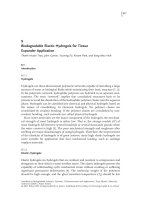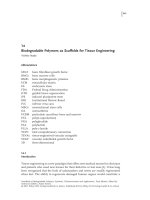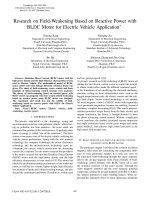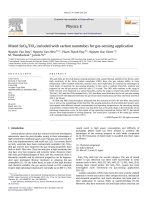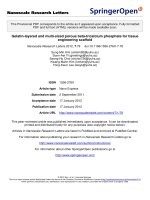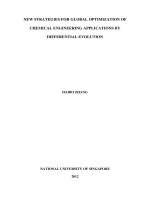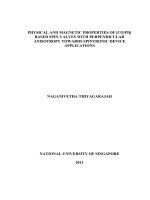Engineering aggregates with chemical linkers for tissue engineering application
Bạn đang xem bản rút gọn của tài liệu. Xem và tải ngay bản đầy đủ của tài liệu tại đây (3.75 MB, 127 trang )
ENGINEERING AGGREGATES WITH CHEMICAL
LINKERS FOR TISSUE ENGINEERING APPLICATION
HE LIJUAN
NATIONAL UNIVERSITY OF SINGAPORE
2006
ENGINEERING AGGREGATES WITH CHEMICAL
LINKERS FOR TISSUE ENGINEERING APPLICATION
HE LIJUAN
(B. Eng., ZJU, China)
A THESIS SUBMITTED FOR THE DEGREE OF
MASTER OF SCIENCE
GRADUATE PROGRAM IN BIOENGINEERING
NATIONAL UNIVERSITY OF SINGAPORE
2006
ACKNOWLEDGEMENT
This research began one and half years ago when I settled in A/P Hanry Yu’s lab,
when I started my second lab rotation. The first person I really would like to thank is
my direct supervisor Hanry Yu. He has been impressing on me for his enthusiasm in
research and his mission for high quality work. I am very grateful to him for showing
me the way of research as well as the consistent help and advice he has been
providing me as close as a relative and a good friend.
I am also deeply indebted to my co-supervisor Dr. Tan Choon Hong, who has been
keeping an eye on my research and was always there whenever I need his advice
during all the time of research and writing of this thesis.
I am especially obliged to Ong Siew Min, Tee Yee Han, Nguyen Thi Thuy Linh and
Zhao Deqiang who are all my colleagues of the project, giving me the feeling of being
at home at work. My former colleague, Dr Tang Guping, although he left Singapore
one year ago, I still want to extend my gratitude to him, without whom I could never
explore out the way in this absolutely new research field
Needless to say, that I need to thank all of my colleagues in Prof. Hanry Yu’s lab, who
provided me a lot of constructive ideas and advices during my research and
discussions of my thesis, especially Dr. Chia Ser Mien, Susanne, Khong Yuet Mei,
i
Toh Yi Chin. I also want to thank Toh Yi Er for her techinical support on microscopy.
I feel a deep sense of gratitude for my father and mother who formed part of my
vision and taught me the things that really matter in life. The encouragement of my
father still provides a persistent inspiration for my journey in this life.
Finally I want to extend my appreciation to all of the friends who has been caring for
me and helping me during the past two years.
ii
TABLE OF CONTENTS
ACKNOWLEDGEMENT............................................................................................i
TABLE OF CONTENTS........................................................................................... iii
SUMMARY .................................................................................................................vi
LIST OF FIGURES AND TABLES ....................................................................... viii
LIST OF SYMBOLS ...................................................................................................x
Chapter 1 Introduction................................................................................................1
1.1 Tissue engineering................................................................................................1
1.1.1 Overview of tissue engineering .....................................................................1
1.1.2 The strategy of Scaffolds and their limitation................................................3
1.1.3 Micropattern in tissue engineering.................................................................5
1.1.4 Organ printing – a novel approach in tissue engineering ..............................7
1.2 Cell Aggregates ....................................................................................................9
1.2.1 Reaggregate approach in tissue engineering..................................................9
1.2.2 Previous way to get aggregates....................................................................10
1.2.3 Previous application of cell aggregates........................................................12
1.3 Cell surface engineering.....................................................................................13
1.3.1 Introduction to cell surface ..........................................................................13
1.3.2 Chemical strategies to engineer cell surfaces ..............................................14
1.3.3 Applications of surface engineered mammalian cells..................................18
1.4 Application of Poly (ethylenimine) and dentrimers in bioengineering ..............20
1.4.1 Chemistry of Poly (ethylenimine) and dentrimers.......................................20
1.4.2 Biological application of PEI and dentrimers..............................................23
1.4.3 Cytotoxicty of PEI and Dentrimers..............................................................25
1.5 Project outline ....................................................................................................26
Chapter 2 Preliminary study of chemical linkers for aggregates formation ........29
2.1 Cell surface modification detected with streptavidin - FITC .............................29
2.2 Synthesis of various types of chemical linker ....................................................31
iii
2.3 Cytotoxicity of chemical linkers ........................................................................33
2.4 Ability to aggregate cells....................................................................................34
2.5 Size distribution of aggregates ...........................................................................36
2.6 Live and Dead Assay of aggregates ...................................................................41
2.7 Comparison of the different types of chemical linkers. .....................................44
Chapter 3 Engineering Aggregates in a Rapid, Non-toxic and Controllable way46
3.1 Aggregation ability characterization of the chemical linker ..............................46
3.1.1 Number of hydrazide groups tested by Ellman’s test ..................................46
3.1.2 Formation of aggregates by PEI-2000-hy in a rapid way ............................47
3.1.3 Efficiency of this aggregating system..........................................................49
3.1.4 Importance of positive charge for PEI-2000-hy as an efficient linker.........51
3.2 Cytotoxicity of this aggregating system.............................................................53
3.2.1 Cytotoxicity of modification by NaIO4........................................................53
3.2.2 Cytotoxicity of PEI-2000-hy(PEI-2000-iminothiolane-hydrazide).............56
3.2.3 Live and Dead Assay of the Aggregates ......................................................57
3.2.4 Culture of the aggregates .............................................................................61
3.2.5 Fate of chemical linker.................................................................................67
3.3. Ability of controlling aggregates using chemical linking system .....................72
3.3.1 Control the size distribution by linker concentration changes.....................72
3.3.2 Manipulating cells into defined structure by stenciling and
micromanipulation ................................................................................................74
Chapter 4 Conclusion and Future Work .................................................................76
Chapter 5 Materials and Methods............................................................................79
5.1 Cell culture .........................................................................................................79
5.2 Determination of surface modification by NaIO4 on HepG2 cell surface .........79
5.3 Synthesize of the chemical linkers .....................................................................80
5.4 Characterization of the chemical linkers – Ellman’s test ...................................81
5.5 Cytotoxicity test of the chemical linkers............................................................82
iv
5.6 Synthesize of fluorescence PEI-2000-hy ...........................................................83
5.7 Cytotoxicty of NaIO4 on cells ............................................................................83
5.8 Formation of cell aggregates by modified cells and chemicals..........................85
5.9 Statistics on aggregates size distribution............................................................86
5.10 Live and dead assay of the aggregates .............................................................86
5.11 Culture of cell aggregation ...............................................................................87
5.12 MTS assay of the aggregates............................................................................87
5.13 Track the fate of chemical linker by fluorescence tagged PEI-2000-hy ..........88
5.14 Micropatterning ................................................................................................88
5.15 Micromanipulation ...........................................................................................89
5.16 Statistical analysis ............................................................................................89
REFERENCES...........................................................................................................90
v
SUMMARY
This thesis explored a novel way to engineer artificial multicellular structures
combining principles from tissue engineering, cell surface engineering and chemistry.
Instead of using classical tissue engineering approach, which involves seeding cells
into polymer scaffold or hydrogels, we tried to work on cell aggregates as building
blocks for tissue engineering. The one-native cell-surface ketone epitopes produced
by cell surface modification provides a stable molecular handle for the attachment of
other molecules to cells. By combining the function of reacting with non-native
groups on cell surface, and that of linking different cells, we synthesized five different
kinds of chemicals shown to construct aggregates efficiently. The chemicals within
defined concentrations have low cellular toxicity. In addition, the size distribution of
the aggregates can be controlled by concentration and nature of the linkers, such as
molecular weight. After comparing the aggregation efficiency and the viability of the
aggregates, PEI-2000-hy was chosen as the model chemical linker for further study.
During the further study of aggregates by PEI-2000-hy, we discovered that this
method provided a simple and efficient way to build multi-cellular structures, such as
cell aggregates. Bi-functional chemicals, with the combined functions of biotin
hydrazide and avidin, were used. Using this one-step linking system, we were able to
achieve cellular aggregates rapidly and efficiently. In order to find out the important
factors for the linkers to be an efficient cell glue, neutral tetra-hydrazide was
vi
synthesized and found to be non reactive to the modified cells, which distinguished
the positive charge possessed by PEI as an important factor for PEI-hydrazide to be an
efficient linker. Besides studying the aggregating ability of this system, we also
studied its cytotoxicity. Inconsistent with published data, we found that sodium
periodate oxidation is the most cytotoxic step in this chemical-linking system.
However, by taking the advantage of charge interaction between the positive linker
and negative cell surface as well as the specific covalent interaction between ketone
sialic acids and hydrazide, we were able to form multi-cellular structures using
relatively low concentration of chemical linker and kept the overall viability of cells.
In order to further prove the feasibility of this new system, the cell aggregates were
cultured in suspension, and showed increased viability up to seven days. Fluorescent
linkers were synthesized and applied in this aggregating system. The ability to
directly observe the presence of fluorescent linkers on cell surfaces enabled us to
track the fate of linker. Disappearance of fluorescent linkers from cell surfaces during
suspension culture hinted us the existence of natural cell-adhesion molecules which
took over the role of gluing the cells together compactly.
In the initial process of engineering aggregates, we could only control the size
distribution of aggregates by changing chemical concentrations but not the shape of
the aggregates. However, in the final stage of the study, we managed to control the
shape of the aggregates by micropatterning and micromanipulation, which
demonstrated the possible usage of this system in tissue engineering.
vii
LIST OF FIGURES AND TABLES
Fig 1.1 Structures of PEI precursors and end products
Fig 1.2 Structures of two frameworks of Dentrimers
Fig 2.1 Distribution of non-native aldehyde groups on HepG2 cells after modification
Fig 2.2 Reaction scheme of 2-iminothiolane and amino group
Fig 2.3 Route of synthesis of chemical linkers
Fig 2.4 The cytotoxicity of chemicals tested by MTS assay
Fig 2.5 Cell aggregates by different kinds of chemical linkers
Fig 2.6 Distribution curve of cells in different sizes of aggregates
Fig 2.7 Live and dead cells in aggregates
Fig 2.8 Quantification of live and dead images in Fig 2.7
Fig 2.9 Comparison of five types of chemicals
Fig 3.1 Aggregation formation of HepG2 cells from PEI-2000-hy
Table 3.1 The shortest time for formation of aggregates > 10 cells
Fig 3.2 Aggregation efficiency under different concentration PEI-2000-hy
Fig 3.3 Positive charge is necessary of fast formation of the multi-cellular structure by
chemical linker
Fig 3.4 Cytotoxicity test of NaIO4 treatment to cells
Fig 3.5 Cytotoxicity of PEI-2000-hy
Fig 3.6 Live and dead assay of aggregates from PEI-2000-hy
Fig 3.7 Quantification of Live and Dead assay in Fig 3.6
viii
Fig 3.8 Phase Contrast images of the aggregates on different days during culture in
suspension up to 7 days
Fig 3.9 Live and Dead assay for culture of aggregates
Fig 3.10 Quantification of images in Fig 3.9
Fig 3.11 MTS data of cell aggregates in suspension culture
Fig 3.12 Fluorescence linker observed by Olympus Fluoview 500
Fig 3.13 Fate of chemical linker on cell surface in continual culture
Fig 3.14 Quantification of amount of fluorescence remaining on cell surface
Fig 3.15 Distribution curves of the sizes of aggregates from PEI-2000-hy
Fig 3.16 The structure of the aggregates can be controlled by stenciling or
micromanipulation
ix
LIST OF SYMBOLS
PDMS
Poly (dimethylsiloxane)
PEI
Poly (ethylenimine)
PAMAM
Polyamides and amines
2-IT
2-iminothiolane
HAS
Human serum albumin
FITC
Fluorescein 5'-isothiocyanate
EMCH
E- maleimidocaproic acid hydrazide. HCl
DAB-Am-4
Polypropylenimine tetramine dentrimer, Generation 1.0
DAB-Am-8
Polypropylenimine octaamine Dendrimer, Generation 2.0
DAB-Am-16
Polypropylenimine hexadecaamine Dendrimer, Generation 3.0
PI
Propidium iodide
PBS
Phosphate buffered saline
DMEM
Dulbecco’s modified Eagle’s medium
MTS
Mitochondrial reduction of tetrazolium salts into soluble dye
FBS
Fetal bovine serum
DMSO
Dimethyl Sulfoxide
MWCO
Molecular weight cut-off
EDTA
Ethylene diamine tetra-acetic acid
CTG
CellTracker™Green
CTB
CellTracker™Blue
x
Chapter 1 Introduction
1.1 Tissue engineering
1.1.1 Overview of tissue engineering
In the field of tissue engineering, principles of engineering and life sciences are
integrated to develop biological substitutes that can restore or improve tissue
functions [1, 2]. Isolated cells or cell substitutes, tissue-inducing substances, and cells
placed on or in matrices, have been the most general strategies for creating new
tissues [2]. Engineered tissues can be used to improve burn treatment, dental implants,
bone, and cartilage transplants, as well as to replace the function of organs such as
liver and kidney [3]. There are several challenges before these types of treatment are
fully realized, including finding reliable sources of compatible cells, utilizing the stem
cells efficiently and differentiating them properly into functional tissue, and
optimizing the design and fabrication of scaffold.
Tissue engineering usually starts with cells derived from the patient or from a donor.
According to the specific application, different cell types are needed from different
sources. For example, articular, auricular, and costal chondrocytes are able to produce
cartilaginous matrix that forms mechanically bonds with native cartilage, which
makes them applicable in cartilage tissue engineering [4]. Primary hepatocytes are
most commonly used in current liver engineering therapies although highly functional
1
hepatocyte cell lines are being developed [5-7]. Besides these mature cell types,
immature cells in the stem cell stage can also be used [8]. Bone marrow stem cells are
popular for bone and cartilage tissue engineering nowadays. Recently, people found
that human embryonic stem cells can rescue injured hear in a clinical trial [9]. In
addition to cell sources, some kind of 3-D scaffold is required to provide physical
support for cells to grow outside of the human body. The design and fabrication of
scaffolds has attracted much attention recently [10, 11]. In order to form hierarchical
structures, which are similar to native tissues, chemical and mechanical signals are
also needed at appropriate times and places to induce cellular growth. People
immobilized galactose, which is specifically targeted to asiaglycoprotein receptors
(ASGPR), on hepatocytes membrane, on poly (D, L-lactic-co-glycolic acid) (PLGA)
surface to promote specific cell adhesion [12]. It was also found that the hepatocyte
functional fate could be engineered in vitro by variable mechanochemical properties
of the extracellular microenvironment [13], as well as the uses of growth factors [14].
Applications of tissue engineering can be broadly classified into two types. One is its
therapeutic application in which the tissue is either grown in a patient or outside the
patient before it is transplanted [15-20]. The other application is diagnostic
applications, in which the tissue is made in vitro and used for testing drug metabolism,
uptake, toxicity, pathogenicity, etc. [21-24]. In both applications, how to cause
biological tissues to regenerate in vitro is the key problem. Development of this field
is stimulated by that in gene therapy, polymer science, and cell biology [25]. With fast
2
development of these areas, it is possible that laboratory-grown tissue replacements
will become a common medical therapy during the early decades of the 21st century
[26]. However, different from simple cell culture, in which cells reproduce their own
structure with essential nutrients provided in a proper environment, high level of
structures must be produced before functional tissue can be constructed [27]. What
determines cell organization and differentiation in tissues? Is it possible to permit the
fine control of tissue architecture for the engineered tissues to become clinically
useful? All of these questions require solving.
1.1.2 The strategy of Scaffolds and their limitation
There are many different ways to engineer tissues. The majority one relies on forming
homogeneous, porous scaffolds that are then seeded with cells [1, 28-32]. These
scaffolds are traditionally made from polymers, hydrogels, or organic/inorganic
composites. They play the function of providing the required mechanical support for
the cells and a frame for growth and differentiation [2, 30]. The overall tissue size and
shape can be molded by biodegradable scaffolds. Flexibility of scaffold makes it
possible to optimize the microgeometry for cell recruitment. In addition, the synthetic
polymer can be controlled to degrade as the tissue forms [33-37]. It is now well
known that viability and function of surface-attached cells depend on the properties of
the surface. In fact, synthetic surfaces can be chemically modified to replicate the
chemical [38, 39] and physical [40-42] features of tissues, rendering materials active
for specific types of cell populations. Beside proper surface properties, mechanical
3
strength of three-dimensional scaffolds, in most tissue engineering is also required for
implantation and interconnected channels are essential prerequisites for cell growth
and nutrients to permeate the entire scaffolding [43-46].
The design of scaffolds for tissue engineering contains several levels, which include
macroscopic level (on a scale of millimeters to centimeters); an intermediate level
(hundreds of microns), involving the topography of pores and channels; and the
molecular level, involving surface texture and chemistry (tens of microns) [10].
Current research and development in biomaterials are trying to solve problems across
these spectrums. Studies of basic biological and biophysical processes at the
molecular and cellular level, are required so that we understand what processes the
cells need help with and what events they can accomplish by themselves [47-49].
Studies at this end of the spectrum have led to the development of new tools for
biologists to use in fundamental studies of cell behavior, which in turn lead to better
bioactive biomaterials. At the other end of the spectrum, scaffolds are needed to direct
the macroscopic process of tissue formation [50-53]. There are two challenges
existing. Firstly, the first generation of degradable polymers widely used in tissue
engineering, was adapted from other surgical uses and has some deficiencies in terms
of mechanical and degradative properties. New classes of degradable materials are
being developed [54-56]. The second challenge is how to fabricate these relatively
delicate polymers into scaffolds that have defined shapes and a complex, porous,
internal architecture that can direct tissue growth [57-59]. A variety of new
4
approaches are being developed under the classical engineering constraints of cost,
reliability, government regulation, and societal acceptance. Micropattern and
computer-based printing techniques, which are among the emerging new strategies,
will be reviewed in 1.1.3 and 1.1.4 separately.
Despite development of scaffolds for tissue engineering application, there exist
several problems with this method. The first one is that penetration and seeding of
cells is not effective enough. Uniformity of cells throughout the scaffold, without
proper external guiding signals, is also a problem. Although significant progress has
been made in designing scaffolds that enable effective seeding and cell migration [60],
it is still far from optimal. The second problem is that natural organs usually contain
many cell types, and it is a challenging technical problem to place different cell types
in defined positions [61, 62]. The third problem is that different types of scaffold are
required for engineering tissues which differ in properties. Besides the above
problems, the absence of vascularization is the key problem for solid scaffold larger
than 200 um. Currently, many scientists are trying to use different ways to construct
the vascularization tissue [52, 63-66].
1.1.3 Micropattern in tissue engineering
Function of tissue is modulated by the spatial organization of cells on a micrometer
scale. So it is quite important to engineer tissue to replicate natural cellular structures
so that we can understand, simulate and measure their in vivo functions. However,
5
selective attachment of cells on surface has always been a technological challenge.
People tried severaldifferent ways such as scratched extracellular matrix pattern [67]
to guide attachment, spreading and migration of cells. Recently the silicon
microfabrication techniques and development in surface chemistry made it possible to
design the biochemical composition of substrate [68, 69], the matrix surrounding a
cell [70, 71] and the cell type contacting each other [61, 62]. Normally a template to
which cells attach preferentially is microfabricated before the selective cell
attachment is achieved. The template can be made of metals [72], self-assembled
monolayers [73], polymers [74], extracellular matrix proteins [75] or cell adhesive
peptides [76].
An alternative to this template-based pattern is to deliver cell suspension onto specific
regions of a substrate by microfluidic channels [77, 78]. However, this method can
only be applied to a few cell types with slow metabolism. Another alternative way is
to use a stencil, which is a thin sheet containing holes of specialized shapes and sizes.
Metallic stencils were micromachined to generate cellular micropatterns as early as
1967 [79]. However, the difficulty of metallic to seal against the substrate and the
challenge involved in fabrication of metallic stencils with diameters around 10-15um,
the size of single cell prevents the further application of metallic stencils [80]. More
recently, people have successfully made cellular patterns of many adherent cell types
through the fabrication of Poly (dimethylsiloxane) (PDMS) stencil [81]. The stencil
can be applied to cell culture substrate before cell seeding and peeled off manually
6
after seeding. The stencils can be replicated many times from the same master since
the replication process does not damage the mold, which make precise repeatability
possible over large surface areas.
A common drawback of all these methods mentioned above is that they are
topologically constrained to two-dimension. In order to reproduce tissue structure
functional in three-dimension, people tried to fabricate three-dimensional microfluidic
structures by stacking membranes in PDMS using proto-typing [82-84]. Although
fabrication 3D PDMS mold is much more complex than fabricating simpler structures,
this is a versatile technology to pattern multiple types of cells or proteins in complex
continuous surface. Since tissues of mammalian organisms always exhibit
complicated micro-architecture related with different cell types, the ability to pattern
different cell types in 3D defined structures paves the way to study the relationship
between function and structure of tissue in single cell resolution.
1.1.4 Organ printing – a novel approach in tissue engineering
Besides micropattern to control the shape of engineered tissue in vitro, methods to
print patterns and structures of scaffold are worked out recently as novel ways to
replace traditional techniques in tissue engineering [85]. Computer designs are
utilized in some approaches to fabricate complex 2-D and 3-D structures directly from
the basic elements. Several different printing technologies have shown the ability to
create porous polymer scaffolds with both macroscopic and microscopic structures
7
[86]. However, seeding cells in these scaffolds only leaves a homogeneous mass of
cells which does not resemble the heterogeneous structure of tissue. There are some
more advanced methods of cell seeding which possibly could place different types of
cells and biomaterials into the scaffold in organized patterns. They could thereby
create heterogeneous constructs [87, 88]. One possible way to accomplish this seeding
approach would be using a tool to print cells into single layers of scaffolds, then the
entire tissue-like constructs can be built by using a layer-by-layer approach [88].
Based on the concept of printing cells, several researches have been done during the
past few years. Previous experiments have been done to demonstrate that embryonic
chick spinal cord cells could be printed to a substrate using a laser guidance machine
[89, 90]. In addition, both prokaryotic and eukaryotic cells were shown to remain
viable after printing cell patterns with a modified laser transfer technique [91]. A
recently modified ink jet machine was used to print patterns of bovine aortal
endothelial cells [92-94]. All of these above techniques have the ability to enhance the
traditional cell-seeding process in tissue engineering by placing single or multiple cell
types into scaffolds precisely controlled by computer.
Until recently, this technology of printing cells was limited to the printing of 2D
tissue constructs. A new opportunity for extending the printing technology to three
dimensions is created by the emerging use of thermo-reversible gels [95]. The gels,
which are nontoxic, biodegradable, thermo-reversible, can be used as a sort of “paper”
8
and the cells are used as the “ink.” 3D constructs could be generated by dropping one
layer of gel onto another layer of gel, which has already been printed with cells. This
technology termed “organ printing” [92, 94] enables complex 3D organs with exact
placing of different cell types to be printed in a few minutes. Previous work also
showed that cell aggregates which are placed closely in a 3D gel can fuse into
structure defined by initial location of the aggregates [96]. This proves the feasibility
of this method in the area of tissue engineering.
1.2 Cell Aggregates
1.2.1 Reaggregate approach in tissue engineering
Regeneration of simple animals and whole vertebrate tissues was achieved in
reaggregation experiments several decades ago [97]. It is attempted to regenerate
more or less complete tissues or organs from dispersed cells of a particular origin
under specifically controlled culture conditions. The technique includes dissociation
of tissue enzymatically or mechanically, reaggregating of the dispersed cells into
multi-cellular spheres by rotation in suspension, and culture of spheres in regular
culture dishes, spinner flasks, or in conical tubes within roller drums [98, 99].
Suspension cultures of 3D spheres allow tissue growth in all three dimensions [100].
It was also found that compared with cells in monolayer cultures, the cells in
3D-spheres have higher proliferation rates and their differentiation more closely
resembles that in situ [101-103].
9
1.2.2 Previous way to get aggregates
One of the oldest ways that 3D spheroids of cells can be obtained is by spontaneous
cell aggregation, which can generate somehow spherical cellular structures or by
culturing cells on artificial substrates that induce cellular differentiation and maintain
cellular function. Malignant cells are able to adhere to each other to form homotypic
aggregation [104] or adhere to other cells resulting in heterotypic aggregation [105].
However, because of mass transportation limit, accumulation of metabolic waste and
lack of nutrient becoming progressively serious deep within the spheroid, most of the
proliferating cells were present on or near the surface [106].
For cells in suspension to grow as 3D aggregates or spheroids, it is required that the
adhesive forces between the cells are greater than that between cells and the substrate
the cells are cultured on. The simplest way to prevent adherence of cells to substratum
is to use liquid overlay technique, which prevents deposition of matrix [107]. Using
this method, spheroids are formed following a biphasic process. In the first phase,
cells migrate towards each other on the substratum and aggregate into spheroids,
whereas in the second phase, cell growth results in the increase of spheroid size [108,
109]. In order for spheroid to form in this way, different substratums are required for
different types of cells. For example, primary hepatocytes spheroid can be formed by
culturing cells on positively charged surfaces or dishes coated with an extracellular
matrix protein such as proteoglycan [110], poly-(2-hydroxyethyl methacrylate) [101,
10
111], or poly-N-isopropyl acrylamide [112]. Breast cancer cells are grown over an
agar base or reconstituted basement membrane [107].
Liquid overlay cultures in static environment are useful in studying individual
spheroids, whereas spinner flasks are used to provide dynamic suspension when
greater numbers of spheroids are cultivated. Spinner flasks are stirred tank bioreactors,
in which mixing of impeller keeps the cells from settling down. The movement of
fluid theoretically plays the role of assisting mass transportation of nutrients and
wastes into and out of the spheroids separately [113]. Although the most widely used
method for culturing large numbers of multicellular spheroids was spinner flask
culture [114], roller tubes and gyratory shakers were also used somehow successfully.
People found that 80% of hepatocytes can form spheroids within 6hrs of spinner
culturing, which is much faster than previous methods, which normally take 24hrs to
96hrs [115].
Rotary Cell Culture System was developed by NASA and it introduced a
revolutionary concept [116, 117]. In this system, cells are maintained in a dynamic
suspension in liquid media mixed by small hydrodynamic forces. Fluid turbulence and
shear forces are minimized in this system, in which the vessel is completely filled
with media and there is a semi-permeable membrane to eliminate bubbles. This
system successfully integrates co-localization of cells, 3D cell-cell interactions,
cell-matrix interaction and minimal shear forces, which provides a mild environment
11
for 3D spheroid cell culture with adequate mixing for mass transportation. This is a
great advantage as higher fluid turbulence in the spinner flask was shown to damage
fragile animal cells and affect the integrity of membrane as well as normal
metabolism [118].
Other methods used by previous people to get cell aggregates include scaffold-based
culture and hanging drop method. Hepatocyte-like spheroid structures could form in
three-dimensional peptide scaffolds from putative liver progenitor cells [119].
Hydrogel-coated textile scaffolds was also found to be a good candidate in liver tissue
engineering as they permit favorable hepatocytes attachment, spheroid formation and
thus the maintenance of function [120]. The recent emergency of hanging drop
method provides a mild, straightforward way to produce spheroids of homogeneous
size, which are applicable to many anchorage-dependent cell types [121, 122].
1.2.3 Previous application of cell aggregates
Previous application of reaggregates experiments can be divided into two types
according to time scale, short-term experiments, which last from minutes to a few
hours and long-term ones which last from several hours to a few days. Short-term
reaggregation has been used widely to analyse cell–cell interactions, cell surface
properties, and to characterize cell adhesion molecules [123-125]. The reaggregate
approach in longer time scale allows study of the formation of tissue-like cell
arrangements. However, reaggregate approaches do not have a cellular pattern from
12
which the tissue originates [126]. Thus, a primary goal of the reaggregate approach is
not to simulate normal tissue formation but to reveal basic mechanisms involved in
this process. Take the aggregates formed in monolayer cultures for example, the
reaggregate approach enables us to follow the process of tissue formation from single
cells to organized spheres in a controlled environment so that we can understand
better the inherent principles of tissue formation [127].
1.3 Cell surface engineering
1.3.1 Introduction to cell surface
The cell membrane of mammalian cells contains several different components,
including lipids, proteins and carbohydrates. These components are constructed to
generate the sophisticated functions of the membrane, such as uptake of molecules
selectively into the cell, specific communication between cells as well as that between
cell and extracellular matrix [128]. Besides its complexity, the cell membrane is also a
dynamic structure that changes its chemical constituents and its overall composition
from time to time according to the change of its environment. One example is that
during tissue development it is by changing carbohydrate and protein handles on the
outer plasma membrane that the individual cell influences tissue morphogenesis.
Because of the heterogeneity of cell membranes, they become a challenging
environment in which non-native chemical species are introduced. In addition to this,
chemical modification on the cell surface should be insured not to induce undesirable
changes in cell behaviors, which further complicates the area of cell surface
13
